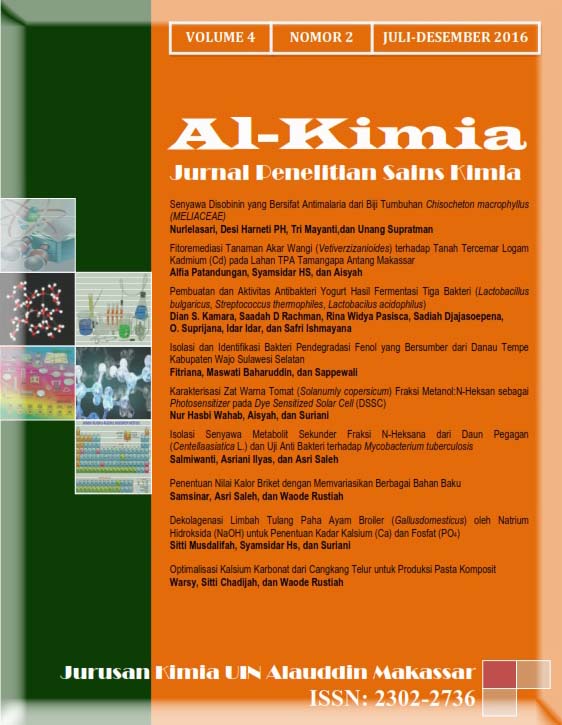Penentuan Nilai Kalor Briket Dengan Memvariasikan Berbagai Bahan Baku
Abstract
Limitations of the availability of non-renewable energy sources. Cocoa shell waste and sawdust widespread everywhere and can be used as an alternative energy source that is to cultivate and make fuel, one of which briquetting. The composition of the material that is (90: 10 75: 25 and 50: 50). After mixing the briquettes are printed using a printer briquettes. From this study, the best calorific value contained in the ratio of sawdust 90: Water Hyacinth 10 is 6223.20 cal/g, the ratio of sawdust 90: 10 cocoa skin is 5953.72 cal / g and Leather Cocoa 90 : Water Hyacinth 10 ie 6066, 09 cal/g. The best density value in comparison sawdust: cocoa skin (75:25) ie 1.05 kg/cm3. Best values compressive strength in comparison cocoa skin: water hyacinth (50:50) ie 2.32 kg/cm3. Best water content ratio of sawdust : water hyacinth (90 : 10) ie 3. 89% ash content. Value best comparison Leather cocoa : water hyacinth (90 : 10) is 0.66%. Volatile matter best value comparison cocoa skin: water hyacinth (90:10) ie 13.1%. The best comparison value of fixed carbon sawdust: cocoa skin (90 :10) is 62,34 %.
Downloads
References
Aristyanto, Eko., 2004, Pembuatan Biobriket dari Campuran Limbah Kulit Pisang dan Serbuk Gergaji Menggunakan Perekat Tetes Tebu, Jurnal Teknik Kimia, 12(3).
Budi, Esmar., 2011, Pemanfaatan Briket Arang Tempurung Kelapa Sebagai Bahan Bakar Pengganti, Jurnal Fisika, 12(2).
Departemen Agama, 1989, Al Quran dan terjemahannya, Semarang: CV Toha Putra.
Dogra, SK., 2009, Kimia Fisik dan Soal-Soal, Jakarta: UI – Press.
Fachri, Rasyidi, A., 2010, Mencari Suhu Optimal Proses Karbonisasi dan Pengaruh Campuran Batubara Terhadap Kualitas Briket Eceng Gondok, Jurnal Teknik Kimia,17(2).
Gandhi, Aquino., 2010, Pengaruh Variasi Jumlah Campuran Perekat Terhadap Karakteristik Briket Arang Tongkol Jagung,Jurnal Teknik Kimia, 8(1).
Himawanto, Dwi Aries, 2013, Penentuan Energi Aktivasi Pembakaran
Briket Char Sampah Kota Dengan Menggunakan Metoda Termogravimetry dan Isotermal Furnace, Jurnal Sains. 15(3).
Holman, J.P., 1995,Kalor Perpindahan, Jakarta: Erlangga.
Irfanti, Eka., 2013, Karakterisasi Briket Bioarang Limbah Kulit Pisang Uli (Musa Paradisiaca) dengan Perekat Tepung Tapioka, Jurnal Teknik Kimia, 14(2).
Martinis, Munas., 2012, Pembuatan Biobriket dari Limbah Cangkang Kakao, Jurnal Teknik Kimia, 20(3).
Mirnawati, 2012, Pengaruh Perekat Getah Pimus Terhadap Peningkatan Nilai Kalor dari Tempurung Kelapa dan Sekam Padi, Jurnal Kimia, 18(5).
Nasirotunnisa, 2010, Analisis Nilai Kalor Bahan Bakar Biomassa yang Dapat Dimanfaatkan Menggunakan Kompor Biomassa, Skripsi, Jakarta: Universitas Indonesia.
Putra, Resha Widya, 2012, Peningkatan Nilai Kalor Biobriket Campuran Kulit Mete dan Dominani Sekam Padi Dengan Metode Pirolisa, Jurnal Teknik Mesin, 19(8).
Rosyidi, Jalal Soelaiman, 2013, Perbandingan Karakteristik antara Briket–Briket Berbahan Dasar Sekam Padi sebagai Energi Terbarukan, Jurnal Fisika Fisika, 15(4).
Sari, Noor Mirad, 2009, Analisis Biaya dan Waktu Pembuatan Briket Arang Berdasarkan Bentuk Dari Kayu Bakau (Rhizophora mucronata Lamck) dan Rambai (Sonneratia acidalin), Jurnal Teknik Kimia,20(26).
Sulistyanto, Amin., 2006, Karakteristik Pembakaran Biobriket Campuran Batubara dan Sabut Kelapa, Jurnal Teknik, 2(7).
Teguh Husada, Ibnu, 2010, Arang Briket Tongkol Jagung sebagai energi alternatif, Jurnal Teknik Kimia, 2(7).
Copyright (c) 2016 Al-Kimia

This work is licensed under a Creative Commons Attribution-NonCommercial-ShareAlike 4.0 International License.
Authors who publish with this journal agree to the following terms:
1) Authors retain copyright and grant the journal right of first publication with the work simultaneously licensed under a Creative Commons Attribution License that allows others to share the work with an acknowledgement of the work's authorship and initial publication in this journal.
2) Authors are able to enter into separate, additional contractual arrangements for the non-exclusive distribution of the journal's published version of the work (e.g., post it to an institutional repository or publish it in a book), with an acknowledgement of its initial publication in this journal.
3)Authors are permitted and encouraged to post their work online (e.g., in institutional repositories or on their website) prior to and during the submission process, as it can lead to productive exchanges, as well as earlier and greater citation of published work (See The Effect of Open Access).


